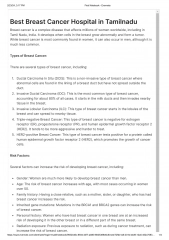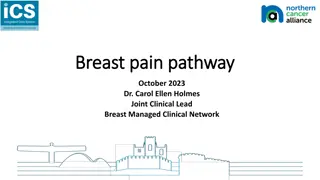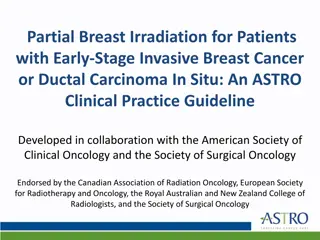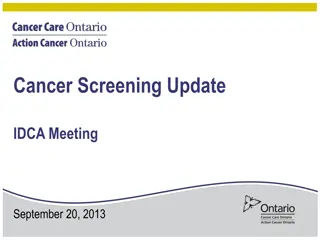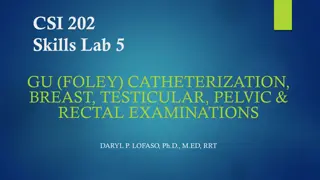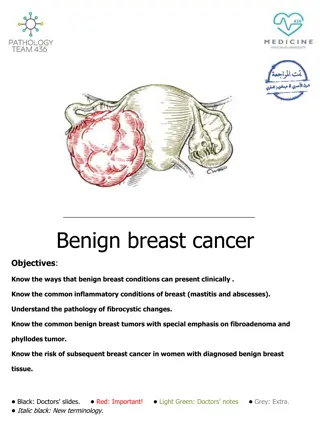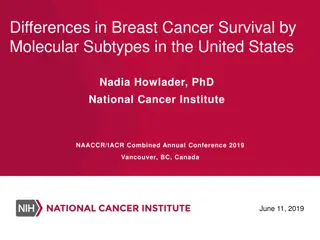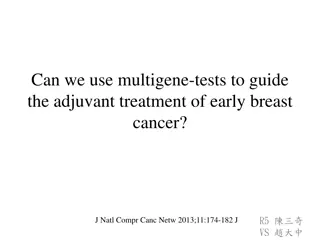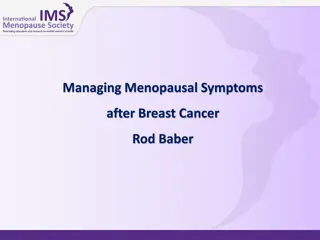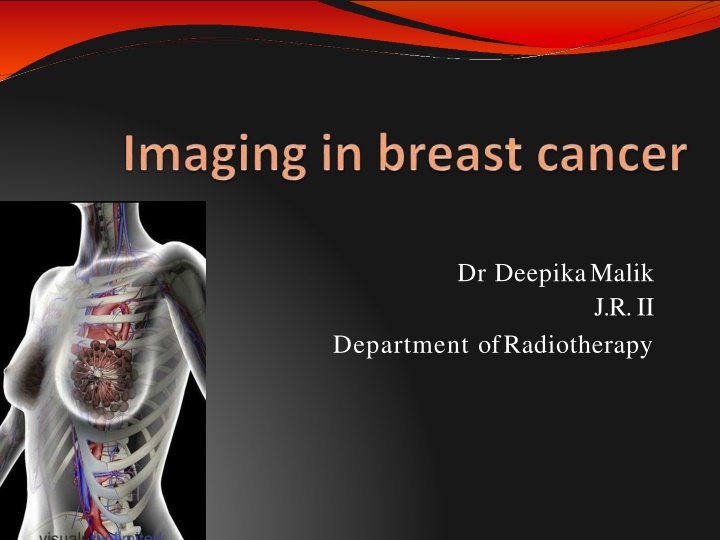
Overview of Breast Cancer Screening and Imaging Modalities
Learn about the importance of breast cancer screening using imaging modalities like mammography, ultrasonography, MRI scan, CT scan, PET scan, and bone scan. Understand the impact of screening on mortality rates and explore guidelines from national organizations for mammography screening. Stay informed on the latest recommendations for early detection and prevention of breast cancer.
Download Presentation

Please find below an Image/Link to download the presentation.
The content on the website is provided AS IS for your information and personal use only. It may not be sold, licensed, or shared on other websites without obtaining consent from the author. If you encounter any issues during the download, it is possible that the publisher has removed the file from their server.
You are allowed to download the files provided on this website for personal or commercial use, subject to the condition that they are used lawfully. All files are the property of their respective owners.
The content on the website is provided AS IS for your information and personal use only. It may not be sold, licensed, or shared on other websites without obtaining consent from the author.
E N D
Presentation Transcript
Dr Deepika Malik J.R. II Department of Radiotherapy
Imaging modalities in breast cancer are used for screening as well as diagnosis. -Mammography -Ultrasonography - MRI scan -CT scan -PET scan -Bone scan
Mammography Is used both as a screening as well as diagnostic tool in breast cancer
Screening Mammogram Before 1977, no formal guidelines existed for screening women for occult breast cancer. The publication of the Health Insurance Plan (HIP) of Greater New York Screening Project, in the 1960s, led the National Cancer Institute and the American Cancer Society to support a breast cancer screening project to evaluate further the efficacy of screening by mammography and physical examination.
At 5 years, the HIP study found a 50% decrease in mortality rate in women older than 50 years of age, but only a 5% decrease in mortality rate in women younger than 50 years of age. With follow-up, the mortality rate in women younger than 50 years of age showed a 23.5% Women who refused screening had no reduction in mortality rate.
Screening Mammogram Although an active area of debate Several authors agree that screening mammography in women 40-49 years of age may reduce mortality from breast cancer Health insurance plan study, (1963-1969) Taber et al (1988-1996) {Canadian study- addition of annual mammography screening had no effect on breast cancer mortality}
National Organizations' Screening Guidelines for Mammography ACS (American college of surgeons) For women for normal risk, yearly mammograms are recommended starting at age 40. CBE suggested about every three years for women in the 30 s and every year for women age 40 and above. BSE is suggested for women starting in their 20s.
NCCN Women at normal risk are recommended to have CBE every 1 3 years; periodic SBE is encouraged. Beginning at age 40, annual CBE and mammograms are recommended, and periodic SBE is encouraged.
NCI Women who are age 40 and above should be screened with mammograms every 1 2 years.
For age group <50 years The National Cancer Institute, American Cancer Society, and the American College of Radiology recommend a baseline mammogram at the age of 35 years (30 years in high-risk groups). Repeat examinations should be carried out every 2 years beginning at 40 years of age. In women older than 50 years, mammograms should be performed annually. Frisell J, Lidbrink E. The Stockholm Mammographic Screening Trial: risks and benefits in age group 40-49 years. J Natl Cancer Inst Monogr 1997:49 51. UK Trial Group. 16-year mortality from breast cancer in the UK trial of early detection of breast cancer. Lancet 1999;353:1909 1914 Kerlikowske K, Grady D, Rubin SM, et al. Efficacy of screening mammography. A meta-analysis. JAMA 1995;273:149 154. Feig SA. Estimation of currently attainable benefit from mammographic screening of women aged 40-49 years. Cancer 1995;75:2412 2419
Diagnostic mammogram most critical component of diagnostic imaging in breast cancer patients bilateral mammograms should be performed routinely in the work-up of the breast cancer patient
Special x-ray machines developed exclusively for breast imaging produce mammography films. use very low doses of radiation and produce high-quality x-rays
The patient wears an open wrap and undress above the waist
Breast is briefly compressed between 2 plates attached to the mammogram machine an adjustable plastic plate on top and a fixed plate on bottom which holds the x-ray film
We should be familiar with the difference between diagnostic and screening mammogram. Screening mammogram- Routine mammogram, done in asymptomatic women 2 views- craniocaudal, mediolateral
Diagnostic mammogram- To characterise abnormalities detected at screening or in women with palpable masses Additional magnification views Done in presence of radiologist generally to determine need for additional views or follow up studies -lateromedial(from side towards center of chest) - mediolateral(from the center of the chest out) - Spot compression view
Mammographic abnormalities Mammographic signs of cancer consist of two primary findings: (1) a mass with ill-defined, irregular, or spiculated edges and/or (2) irregular, pleomorphic calcifications
IDC- mass with illdefined , spiculated margins Benign masses- well defined, with sharp margins, and have little effect on the surrounding breast architecture
Calcifications Could be associated with benign or malignant conditions of breast
Typical popcorn calcification FIBROADENOMA
In malignant tumors calcification 100 to 300 micrometeres, rod like , tubular, branching, punctate
Vascular calcifications These are linear or form parallel tracks, that are usually clearly associated with blood vessels.
Micro-calcifications can be very subtle Biopsy of this area showed 8mm DCIS
In ductal carcinoma in situ (DCIS), there is normally no mass but just an area of calcification
CC and MLO mammographic views show a large and relatively circumscribed ovalar lesion in the upper outer quadrant. On US scan it consists on a complex cyst with a parietal ill-defined mass (arrows). US-guided core needle biopsy of the intracystic mass revealed a malignant phyllodes tumor
The BIRADS ( Breast Imaging and Reporting Data System) classification system is widely adopted in classifying mammograms with respect to appropraite follow up and intervention
Nothing to comment on. Breasts are symmetric ; no masses, architectural disturbances, or suspect calcifications are present. Category 1 Negative
Negative mammogram, but the interpreter may wish to describe a finding. Involuting, calcified fibroadenomas, multiple secretory calcifications, fat- containing lesions such as oil cysts, lipomas, galactoceles, and mixed-density hamartomas all have characteristic appearances, and may be labeled with confidence. The interpreter might wish to describe intramammary lymph nodes, implants, and the like, while still concluding that there is no mammographic evidence of malignancy Category 2 Benign finding
A finding placed in this category should have a very high probability of being benign Not expected to change over the follow-up interval, but the radiologist would prefer to establish its stability. (Data are becoming available that shed light on the efficacy of short-interval follow-up. At present, most approaches are intuitive. These will likely undergo future modification as more data accrue as to the validity of an approach) Category 3 Probably benign finding ---short-interval follow-up suggested
lesions that do not have the characteristic morphologies of breast cancer but have a definite probability of being malignant. The radiologist has concern to urge a biopsy. Category 4 Suspicious abnormality-- ----biopsy should be considered
These lesions have a high probability of being cancer Category 5 Highly suggestive of malignancy----appropriate action should be taken
Finding for which additional imaging evaluation is needed. almost always used in a screening situation and should rarely be used after a full imaging workup. Category 0 Need additional imaging evaluation Perez , 6th edition , pg-1058
Ultrasonography Complementary tool to mammography for diagnosis and screening of breast cancer Cannot replace mammography
Screening USG In a randomised trial of USG and Mammography of 2809 women with dense breasts from ACRIN, Adding a single screening USG yielded and additional 1.1 to 7.2 additional cancers found in high risk women\ But a substantial increase in false positives Role of USG as a screening tool is therefore limited
Diagnostic USG But is a useful tool to complement physical examination and mammography in diagnosis and treatment of cancer. Sensitivity of 73% specificity of 95%
USG Breast is most useful in differentiating cysts from solid tumors Identification and characterisation of palpable and non palpable abnormalities of breast detected by physical examination or mammography.
USG breast--- very accurate (>95%) in diagnosing breast cysts. Cysts have well-demarcated, smooth margins and an echo-free center ; usually rounded and thin- walled and produce distal shadowing. Clear cysts require no further evaluation. Complex cysts that contain evidence of tissue or debris may be aspirated to clarify whether they are simply cysts or represent cystic degeneration of a tumor.
USG as a guide in core biopsies FNA Cyst aspirations Presurgical localizations
NCCN recommends- USG breast for patients with - a dominant mass - assymetric thickening - nodularity
MRI As supplemental tool for screening and diagnosis of breast cancer.
Screening MRI Role of MRI screening is rapidly evolving But unlikely to replace mammography
Its use in screening high risk populations has recently been supported in several studies. Lehman et al ( MRI detected 4 contralateral breast {MMG none} cancers in 103 women with unilteral breast cancer) Kriege et al ( MRI is more sensitive than mammography in detecting tumors in women at high risk for familial breast cancer)
Diagnostic MRI Routine use is controversial Use to supplement mammography in breast cancer diagnosis is rapidly increasing.
Upponi and Warren MRI resulted in an increase in confidence or change in clinical plan in 46% of diagnostic group, 72 % of chemotherapy group, 80 % of screening group. In 44/283 of these MRI resulted in a beneficial change in plan. Esserman etal MRI detected cancer in 55/58 cases; anatomic extent was correctly identified in 98% ,(MMG-55%)
In a woman with dense breasts, the mammogram was normal but the MRI showed the cancer

